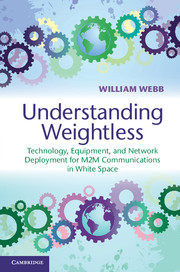Refine search
Actions for selected content:
48243 results in Computer Science
14 - Nonparametric Bayes regression, classification and hypothesis testing on manifolds
-
- Book:
- Nonparametric Inference on Manifolds
- Published online:
- 05 May 2012
- Print publication:
- 05 April 2012, pp 182-208
-
- Chapter
- Export citation
3 - Location and spread on metric spaces
-
- Book:
- Nonparametric Inference on Manifolds
- Published online:
- 05 May 2012
- Print publication:
- 05 April 2012, pp 21-35
-
- Chapter
- Export citation
Appendix C - Dirichlet processes
-
- Book:
- Nonparametric Inference on Manifolds
- Published online:
- 05 May 2012
- Print publication:
- 05 April 2012, pp 218-225
-
- Chapter
- Export citation

Understanding Weightless
- Technology, Equipment, and Network Deployment for M2M Communications in White Space
-
- Published online:
- 05 April 2012
- Print publication:
- 22 March 2012
4 - Extrinsic analysis on manifolds
-
- Book:
- Nonparametric Inference on Manifolds
- Published online:
- 05 May 2012
- Print publication:
- 05 April 2012, pp 36-56
-
- Chapter
- Export citation
10 - Stiefel manifolds Vk,m
-
- Book:
- Nonparametric Inference on Manifolds
- Published online:
- 05 May 2012
- Print publication:
- 05 April 2012, pp 130-134
-
- Chapter
- Export citation
Appendix A - Differentiable manifolds
-
- Book:
- Nonparametric Inference on Manifolds
- Published online:
- 05 May 2012
- Print publication:
- 05 April 2012, pp 209-214
-
- Chapter
- Export citation
Contents
-
- Book:
- Nonparametric Inference on Manifolds
- Published online:
- 05 May 2012
- Print publication:
- 05 April 2012, pp v-viii
-
- Chapter
- Export citation
Appendix B - Riemannian manifolds
-
- Book:
- Nonparametric Inference on Manifolds
- Published online:
- 05 May 2012
- Print publication:
- 05 April 2012, pp 214-218
-
- Chapter
- Export citation
Index
-
- Book:
- Nonparametric Inference on Manifolds
- Published online:
- 05 May 2012
- Print publication:
- 05 April 2012, pp 235-237
-
- Chapter
- Export citation
8 - The planar shape space ??k2
-
- Book:
- Nonparametric Inference on Manifolds
- Published online:
- 05 May 2012
- Print publication:
- 05 April 2012, pp 87-109
-
- Chapter
- Export citation
CUT FOR CORE LOGIC
-
- Journal:
- The Review of Symbolic Logic / Volume 5 / Issue 3 / September 2012
- Published online by Cambridge University Press:
- 02 April 2012, pp. 450-479
- Print publication:
- September 2012
-
- Article
- Export citation
TRACTARIAN FIRST-ORDER LOGIC: IDENTITY AND THE N-OPERATOR
-
- Journal:
- The Review of Symbolic Logic / Volume 5 / Issue 4 / December 2012
- Published online by Cambridge University Press:
- 02 April 2012, pp. 538-573
- Print publication:
- December 2012
-
- Article
- Export citation
Almost sure asymptotic stability analysis of the θ-Maruyama method applied to a test system with stabilising and destabilising stochastic perturbations
- Part of
-
- Journal:
- LMS Journal of Computation and Mathematics / Volume 15 / May 2012
- Published online by Cambridge University Press:
- 01 April 2012, pp. 71-83
-
- Article
-
- You have access
- Export citation
On modular inverses of cyclotomic polynomials and the magnitude oftheir coefficients
- Part of
-
- Journal:
- LMS Journal of Computation and Mathematics / Volume 15 / May 2012
- Published online by Cambridge University Press:
- 01 April 2012, pp. 44-58
-
- Article
-
- You have access
- Export citation
Products of three pairwise coprime integers in short intervals
- Part of
-
- Journal:
- LMS Journal of Computation and Mathematics / Volume 15 / May 2012
- Published online by Cambridge University Press:
- 01 April 2012, pp. 59-70
-
- Article
-
- You have access
- Export citation
Kummer surfaces and the computation of the Picard group
- Part of
-
- Journal:
- LMS Journal of Computation and Mathematics / Volume 15 / May 2012
- Published online by Cambridge University Press:
- 01 April 2012, pp. 84-100
-
- Article
-
- You have access
- Export citation
Testing commutativity of a group and the power of randomization
- Part of
-
- Journal:
- LMS Journal of Computation and Mathematics / Volume 15 / May 2012
- Published online by Cambridge University Press:
- 01 April 2012, pp. 38-43
-
- Article
-
- You have access
- Export citation
Proofs for free: Parametricity for dependent types
- Part of
-
- Journal:
- Journal of Functional Programming / Volume 22 / Issue 2 / March 2012
- Published online by Cambridge University Press:
- 30 March 2012, pp. 107-152
-
- Article
-
- You have access
- Export citation
